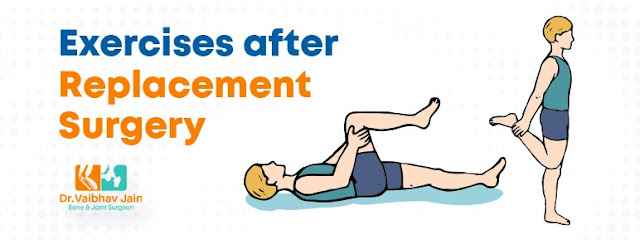Exercises after Replacement Surgery for a Speedy Recovery
Exercises after Replacement Surgery, Joint replacement surgery is a major surgical procedure that can lead to a faster and more comfortable recovery from joint pain. With the right care and rehabilitation exercises, a person can return to a normal functional life.
This blog post will explain the importance of exercise after a joint replacement surgery and the different types of exercises that can be done to speed up the recovery process.
Why Is Exercise Important After Joint Replacement Surgery?
Joint replacement surgery can be a successful procedure that can lead to improved mobility and reduced pain.
However, to ensure a successful outcome, the patient must participate in post-operative rehabilitation. Exercise is a key component of post-operative care and rehabilitation.
Exercises are important after joint replacement surgery because they help to restore strength and joint range of motion, reduce swelling and pain, improve balance and coordination, and prevent contractures.
Exercises can also help reduce the risk of complications such as infection, stiffness, and dislocation, as well as support the healing process. Regular exercise can also help to improve the patient’s overall physical fitness and mental health.
Types of Exercises After Joint Replacement
The type of exercise recommended after joint replacement surgery will depend on the type of surgery and the patient’s health and fitness level. Generally, exercises can be divided into two categories: range-of-motion exercises and strength training.
Range-of-Motion Exercises
Range-of-motion exercises are important for restoring joint flexibility and preventing contractures. These exercises should be done several times a day. They involve gently moving the joint through its range of motion. For example, for a knee replacement, the patient may do a series of exercises such as knee bends, leg circles, and leg lifts.
Strength Training Exercises
Strength training exercises are important for restoring muscle strength and joint stability. These exercises should be done several times a week. They involve using weights or resistance bands to strengthen the muscles around the joint. For example, for a hip replacement, the patient may do exercises such as squats, calf raises, and leg presses.
Tips for Exercising After Joint Replacement Surgery
When starting an exercise program following joint replacement surgery, it is important to start slowly and gradually increase the intensity of the exercises. It is also important to listen to the body and take breaks as needed.
It is also important to work with a physical therapist or other healthcare professional to ensure that the exercises are safe and effective. A physical therapist can also provide guidance and support on how to progress the exercises.
Finally, it is important to take precautions to prevent complications such as infection. It is important to keep the surgical wound clean and dry and to avoid activities that involve excessive sweating or contact with water.
Conclusion
Exercise is an important component of post-operative care and rehabilitation after joint replacement surgery. Range-of-motion exercises and strength training exercises can help to restore joint flexibility, reduce swelling and pain, improve balance and coordination, and prevent contractures.
It is important to start slowly and gradually increase the intensity of the exercises, and to work with a healthcare professional to ensure the exercises are safe and effective. With the right care and rehabilitation exercises, a person can return to a normal functional life.




Best Joint Replacement Doctor in Delhi Knee, Hip & Joint Replacement Surgery in Delhi. Dr Vaibhav Jain is an expert on Knee, Hip & Joint Replacement orthopaedic Surgeon located in Delhi and Noida, India
ReplyDeleteBest Joint Replacement Surgeon in Noida and Delhi - Vaibhav Jain
Best Orthopedic Surgeon In Delhi & Noida
Orthopaedic Treatments
Best Knee Replacement Surgeon In Noida
Hip Replacement Surgery In Noida
Joint Replacement Surgery In Noida
Best Trauma Surgeon In Delhi And Noida
Top Knee Replacement Surgeon In Delhi – Expert Treatment And Care
Best Foods To Eat After Knee Replacement Surgery
Diet Plan After Knee Replacement Surgery
Back To Daily Activities After Knee Replacement Surgery
Tips For A Smooth Recovery After Knee Replacement Surgery
Best Knee, Hip & Joint Replacement Surgery In Delhi Ncr & Noida
Tips For A Smooth Recovery After Knee Replacement Surgery
Running After Knee Replacement
Importance Of Exercise After Knee Replacement Surgery
Most Common Summer Sports Injuries And How To Prevent Them
8 Tips To Speed Up Recovery After Hip Replacement Surgery
Satyam Homoeopathy Clinic
ReplyDeleteAddress:
106, Amazing Star, Near Mahavir Circle, Yogi Chowk, Surat, Gujarat 395006
Phone:
+91 84600 71719
Website:
http://www.satyamhomoeopathy.com/
Dr. Namrata Hisoriya is a homeopathic doctor and counselling psychologist. She has been helping people for over 7 years at Satyam Homoeopathy Clinic in Yogi Chowk, Surat. She treats many kinds of problems, such as illnesses in children, mental health issues, skin problems, breathing problems, joint pain, hair loss, asthma, diabetes and many other diseases. Dr. Namrata is a trusted expert for homeopathic treatment near Yogi Chowk, Surat.
Facebook:
https://www.facebook.com/satyamhomoeopathy
Instagram:
https://www.instagram.com/satyamhomoeopathy/
X(Twitter):
https://x.com/satyamhomeo
Pinterest:
https://www.pinterest.com/satyamhomoeopathyclinic/
Youtube:
https://www.youtube.com/@satyamhomoeopathyclinic
LinkedIn:
https://www.linkedin.com/company/satyam-homoeopathy-clinic/